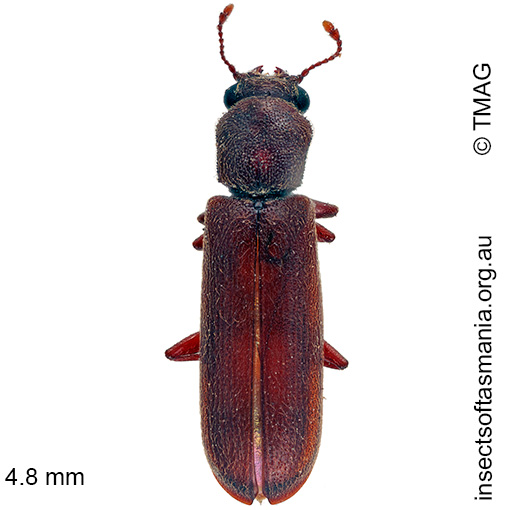
Lyctus brunneus
Basis for Tasmanian occurrence
TMAG collections
Classification
Suborder: Polyphaga
Superfamily: Bostrichoidea
Family: Bostrichidae
Subfamily: Lyctinae
Tribe: Lyctini
Morphology
Typical length (mm): 4.5
Flightedness: winged and assumed capable of flight
Source literature on morphology and taxonomy (*primary taxonomic source, where identified):
Lawrence, J.F. & Britton, E.B. (1994). Australian Beetles. Melbourne: CSIRO. Melbourne University Press.
Ecology
Association with dead wood or old trees: obligately saproxylic
Ecological attributes: — Eucalyptus sp. is a host-plant (Bashford, 1990a) — Can inflict significant damage in timber of Eucalyptus and other spp. (Elliott & deLittle, 1985).
Collection method(s) for TMAG material: — Baited trapping (funnel trap) — Hand collection (substrate not specified) — Panel trapping — Pitfall trapping — Rearing in insectary from Eucalyptus obliqua — Rearing in insectary from Eucalyptus pulchella — Rearing in insectary from Eucalyptus tenuiramis — Rearing in insectary from Eucalyptus viminalis — Sticky trapping (substrate not specified) — Sticky trapping on Eucalyptus obliqua — Sticky trapping on fire-scorched pine.
Source ecological literature:
Bashford, R. (1990a). Tasmanian forest insects and their host plants: records from the Tasmanian Forestry Commission insect collection. Hobart: Tas. Forestry Commission, 32 pages.
Elliott, H.J. & deLittle, D.W. (1985). Insect pests of trees and timber in Tasmania. Hobart: Tas. Forestry Commission, 90 pages.
Harrison, K.S. (2007). Saproxylic beetles associated with habitat features in Eucalyptus obliqua trees in the southern forests of Tasmania. PhD thesis, Dept. of Zoology, Univ. of Tasmania, Hobart.
Webb, G.A. & Simpson, J.A. (1991). Notes on some Australian fungus beetles and their hosts and parasites. Col. Bull. 45: 42-44.

